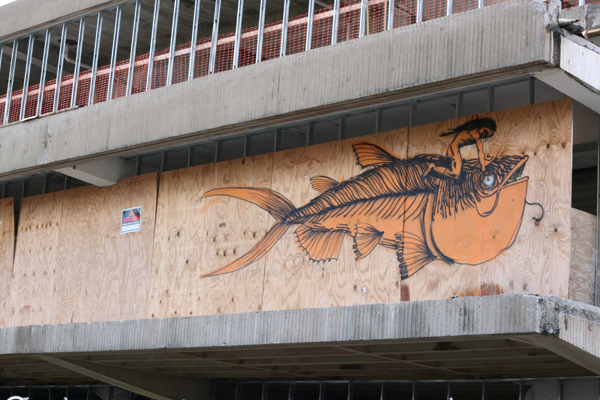
Beyond the blue fences and “Pardon Our Appearance” signs of the Wooster Science Building (WSB) construction site, a duotone orange and black warrior fires an arrow into the eye of a massive whiskered fish.
On the other side of campus, its sister painting depicts a whale breaching out of the spray-painted waters that appeared on the wood walls of the unfinished Sojourner Truth Library renovations.
The street art first appeared within the closed-off construction sites in the fall semester, somewhere in the timeframe of November and December, University Police Chief David Dugatkin said. Dugatkin said the paintings are considered “graffiti” as they are defacing and “technically damaging” campus buildings, requiring at least a bit of maintenance to remove them.
“I respect the art, whatever it might be,” Dugatkin said. “It’s just a matter of where it is put.”
The primary concern of the college is the dangerous locations of the graffiti, Dugatkin said, as the artist climbed into locked construction areas to create the paintings.
“We’re a learning institution and part of this is learning,” Dugatkin said. “Certainly artists want their work to be seen — as they should — but it doesn’t necessarily have to be somewhere where you put yourself or others in danger, or when it damages a building.”
Director of Facilities Management John McEnrue said the safety of the sites belong with the contractor, so “they have every right to prosecute trespassers” who are putting themselves at risk.
McEnrue said the vandalism likely occurred during weekday evenings when contractors were not on site. As a result of the acts, McEnrue said security cameras — capable of working in the evenings — are now placed throughout the sites to discourage any future trespassers.
Third-year visual arts major Manny Robertson said he is “pro-graffiti,” provided the work isn’t offensive or “in the way.” He said he doesn’t see an issue with the paintings being on temporary surfaces like the construction sites.
“It’s a form of painting and expression and there are some mighty fine graffiti artists,” Robertson said. “And it’s not permanent, for the most part.”
Robertson said the paintings make his walk to class more enjoyable. He said the “giant fish with a being on its back” riding toward “the warhorse that is Jacobson Faculty Tower” is particularly striking.
Third-year philosophy and creative writing major Marcella Guarino said the paintings stand out beautifully compared to the construction site canvas.
“Though the artist probably didn’t get permission to use those walls, it’s far from vandalism,” Guarino said. “I’d even say that they have definitely become a part of the New Paltz campus.”
Third-year interpersonal communications major Rachel Kilimnik said she saw several students posting and sharing pictures of the different works on Facebook and Instagram, and most seem to be proud of the “creative environment” of New Paltz.
“I don’t think there is a single student who has walked past the construction site and thought negative things about it,” Kilimnik said.
Kilimnik said she was impressed by the paintings when she first saw them crop up on campus. She doesn’t believe the “art” is vandalism.
“Graffiti defaces property and art enhances it,” Kilimnik said.


